Macros for Gaining Muscle and Cutting Fat
As a macros coach, I’m often asked if someone can gain muscle and lose fat on a macros diet.
It can be tricky, but lean muscle gains can be accomplished by counting macros.
You must be patient and willing to put in the extra effort with nutrition and training.
How to calculate macros to gain lean muscle (bulking)
Traditional bodybuilders use two phases to build muscle and lose fat:
- Bulking
Eat a calorie surplus while engaging in comprehensive weight training. Some fat tissue is also gained. - Cutting
Reducing calories drastically (often includes a very low-fat diet or ketogenic-type diet) and engaging in comprehensive weight training.
The bulk and cut strategy can build muscle and shed fat quickly, but it’s unrealistic for most, especially non-athletic people, with much fat to lose.
Most of us want to gain muscle and lose fat simultaneously instead of in two separate steps.
This is called body recomposition or a lean bulk, and requires careful planning.
Steps for a lean bulk (using macros)
- Maintain a sensible calorie deficit.
Too drastic, and your muscles won’t grow. Too little and fat loss will be extremely slow. - Have a comprehensive weight training program in place
This can be weight training, Crossfit, boot camps, etc., but you must constantly break down muscle tissue, let it repair, and then push harder to break it down again. - Get your diet right
Eat adequate protein that will induce enough protein synthesis to outweigh protein breakdown. - Hormonal levels must be in balance
Both fat loss and muscle growth rely on hormones to release fat stores and build muscle tissue.
The best way to achieve healthy hormones is to eat a healthy, nutrient-dense diet, get plenty of sleep, and exercise regularly.
Steps to calculate the best macro ratio for muscle gain
STEP ONE: Calculate TDEE for your muscle gain goals.
TDEE is your Total Daily Energy Expenditure. It is the number of calories you burn (regular activity and exercise) to stay the same weight.
Once you’ve calculated your TDEE, choose the following options (depending on your goal).
Overall weight gain
Add 20% more calories to your maintenance TDEE.
Lean muscle gain
Add 10% more calories to your maintenance TDEE. Combine with a comprehensive weightlifting program.
Muscle gain while losing fat
Subtract 10% from your TDEE (a calorie deficit). Combine with a comprehensive weight lifting program.
STEP TWO: Calculate your muscle gain macros
There are several good macronutrient ratios for gaining lean muscle, but protein intake is the most essential thing to think about.
PROTEIN
Aim for 0.8 to 1 gram of protein per pound of body weight.
FAT
Consume 25-30% of your calories as fat. Your body needs healthy fat for hormone production and cellular repair.
CARBS
Weight lifting requires explosive strength, so you must eat enough carbs daily to replenish glycogen stores. All remaining calories should be carbs.
The macro calculator will calculate all this for you.
Do I need a lot of calories to build muscle?
Muscle development doesn’t require massive calorie surpluses, but neither can your produce mass from nothing.
Since your body can only develop so much daily, it will store excess calories as fat if you consume a lot.
It’s better to start conservatively and work up instead of eating a lot and then cutting back.
Can you build muscle on maintenance calories?
Eating enough protein and having fat stores to compensate for the excess calories may work for you.
This is not a good strategy for guys already very thin or individuals with a higher body fat percentage.
How your body loses fat
Famine survival requires fat storage.
This system was crucial to our survival thousands of years ago when we hunted and gathered food and sometimes went days or weeks without enough.
Today, food is abundant, and only a grocery cart is needed to get it. We’re still wired like a millennium ago.
- Excess food energy gets stored in the form of fat.
- Fat stores are broken down when the body needs energy it isn’t getting from enough food.
To lose fat, you must consume less energy than you expend on any day.
Your body breaks down fat to make up for the calorie deficit.
How to eat for muscle growth
The body only allocates energy to muscle growth and development if it thinks we need it for survival, whether real or imagined.
Muscle growth occurred naturally when humans had to hunt, build, produce, and labor for survival.
Today, most of us live sedentary lives, so we only need a small amount of skeletal muscle to survive.
Simply eating more will not result in muscle gain, and the extra energy will be stored as fat.
Muscle tissue grows by breaking or injuring muscle fibers (muscle trauma) and rebuilding them with hormones and amino acids.
Muscle trauma occurs with strength training.
The rate of muscle protein synthesis must be greater than the rate of muscle protein breakdown caused by the trauma. Your diet must contain the raw materials needed for protein synthesis.
How to measure your progress
Weighing yourself on the scale is NOT the best option.
Muscle tissue is denser than fat tissue, so the same volume of muscle weighs much more than the same volume of fat.
Your weight may only be going down slightly as you build muscle.
Taking progress pictures and measuring your body fat percentage is a better gauge of your progress.
Get yourself a cheap set of body calipers and use our body fat percentage calculator. Take selfies in the mirror or get your friend or partner to take the pics using the same settings and location each time.
Check you have realistic goals in place. Here’s how body fat percentage breaks down in both men and women.
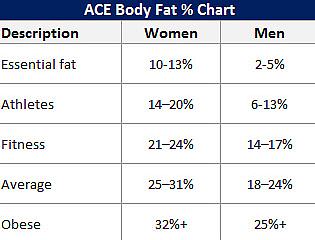
Can you gain muscle while losing fat?
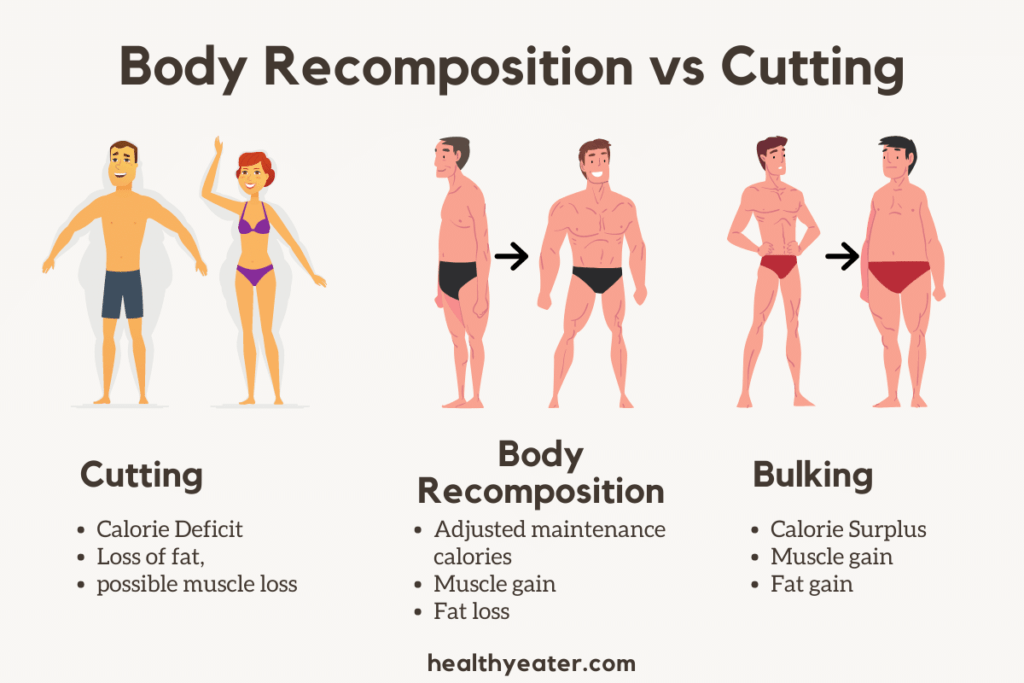
I’ve had great success counting macros to lose fat and build muscle simultaneously. (You can read my story here.)
If you have a background in low-calorie dieting, your hormones could be out of balance, especially the leptin group. It can take time for things to normalize again. Be patient during this process.
Macros aren’t “one size fits all,” so you may have to adjust your TDEE and macros until you find your sweet spot for muscle growth and fat loss.
I found that eating according to how much activity I do each day worked best.
- On rest days, I eat at my sedentary weight loss levels.
- On workout days, I eat more.
- At the gym, continually challenge and push your muscle groups.
This usually means adding more weight to your movements consistently. Doing many reps increases endurance and strength, but doing more weight increases size, so if more size is what you’re after, focus on heavier weights. - I’m a fan of full-body workouts as opposed to isolating muscle groups.
When in a calorie deficit, you must be careful not to break down muscle tissue for resources instead of fat. Working out only arms (for example) could put you at risk of your body cannibalizing your legs for extra protein. - Consuming adequate protein also helps prevent this and is essential.
- I like to have two days of rest in between my whole-body workouts
On those days, I do cardio-type activities.
Sources
- Harms, M., & Seale, P. (2013). Brown and beige fat: development, function and therapeutic potential. Nature medicine, 19(10), 1252-1263.
- Kumar, V., Atherton, P., Smith, K., & Rennie, M. J. (2009). Human muscle protein synthesis and breakdown during and after exercise. Journal of Applied Physiology, 106(6), 2026-2039.
- Timmons, J. A., Baar, K., Davidsen, P. K., & Atherton, P. J. (2012). Is irisin a human exercise gene?. Nature, 488(7413), E9-E10.
- Havel, P. J. (2004). Update on adipocyte hormones regulation of energy balance and carbohydrate/lipid metabolism. Diabetes, 53(suppl 1), S143-S151.


 How to track macros with Cronometer
How to track macros with Cronometer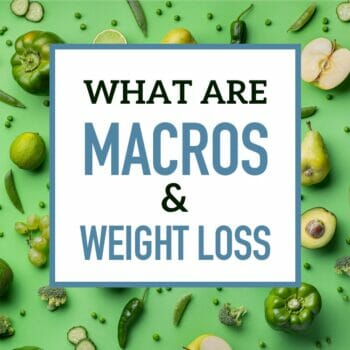 What Are The Best Macros For Weight Loss?
What Are The Best Macros For Weight Loss?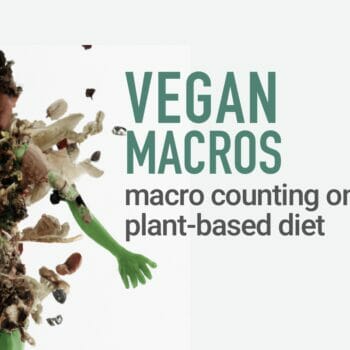 How To Count Macros on a Vegan, Vegetarian, or Plant-Based Diet
How To Count Macros on a Vegan, Vegetarian, or Plant-Based Diet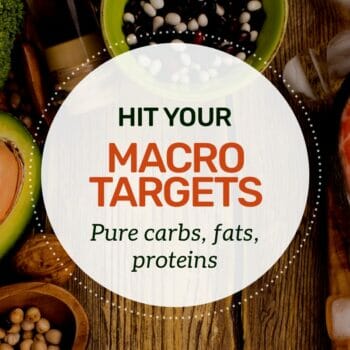 Out of a Macro For the Day? Here’s What to Eat
Out of a Macro For the Day? Here’s What to Eat Macros for Gaining Muscle and Cutting Fat
Macros for Gaining Muscle and Cutting Fat